The Influence of Physical Mixing and Impregnation on the Physicochemical Properties of Pine Wood Activated Carbon Produced by One-Step ZnCl2 Activation
Abstract
1. Introduction
2. Experimental
2.1. Materials and Preparation
2.2. Materials Characterization
3. Results and Discussion
4. Conclusions
Author Contributions
Funding
Data Availability Statement
Acknowledgments
Conflicts of Interest
References
- Owusu, P.A.; Asumadu-Sarkodie, S. A review of renewable energy sources, sustainability issues and climate change mitigation. Cogent Eng. 2016, 3, 1167990. [Google Scholar] [CrossRef]
- Conway, B.E.; Pell, W.G. Double-layer and pseudocapacitance types of electrochemical capacitors and their applications to the development of hybrid devices. J. Solid State Electrochem. 2003, 7, 637–644. [Google Scholar] [CrossRef]
- Frackowiak, E. Carbon materials for supercapacitor application. Phys. Chem. Chem. Phys. 2007, 9, 1774–1785. [Google Scholar] [CrossRef] [PubMed]
- Phiri, J.; Gane, P.; Maloney, T.C. Multidimensional Co-Exfoliated Activated Graphene-Based Carbon Hybrid for Supercapacitor Electrode. Energy Technol. 2019, 7, 1900578. [Google Scholar] [CrossRef]
- Yang, H.; Ye, S.; Zhou, J.; Liang, T. Biomass-Derived Porous Carbon Materials for Supercapacitor. Front. Chem. 2019, 7, 274. [Google Scholar] [CrossRef] [PubMed]
- Raso, R.A.; Zeltner, M.; Stark, W.J. Indoor Air Purification Using Activated Carbon Adsorbers: Regeneration Using Catalytic Combustion of Intermediately Stored VOC. Ind. Eng. Chem. Res. 2014, 53, 19304–19312. [Google Scholar] [CrossRef]
- Liu, F.; Peng, H.; Qiao, X.; Fu, Z.; Huang, P.; Liao, S. High-performance doped carbon electrocatalyst derived from soybean biomass and promoted by zinc chloride. Int. J. Hydrogen Energy 2014, 39, 10128–10134. [Google Scholar] [CrossRef]
- Daud, W.M.A.W.; Ali, W.S.W.; Sulaiman, M.Z. The effects of carbonization temperature on pore development in palm-shell-based activated carbon. Carbon 2000, 38, 1925–1932. [Google Scholar] [CrossRef]
- Ho, S.M. A Review of Chemical Activating Agent on the Properties of Activated Carbon. Int. J. Chem. Res. 2022, 1, 1–13. [Google Scholar] [CrossRef]
- Lu, H.; Zhao, X.S. Biomass-derived carbon electrode materials for supercapacitors. Sustain. Energy Fuels 2017, 1, 1265–1281. [Google Scholar] [CrossRef]
- Yan, B.; Feng, L.; Zheng, J.; Zhang, Q.; Jiang, S.; Zhang, C.; Ding, Y.; Han, J.; Chen, W.; He, S. High performance supercapacitors based on wood-derived thick carbon electrodes synthesized via green activation process. Inorg. Chem. Front. 2022, 9, 6108–6123. [Google Scholar] [CrossRef]
- Zheng, S.; Zhang, J.; Deng, H.; Du, Y.; Shi, X. Chitin derived nitrogen-doped porous carbons with ultrahigh specific surface area and tailored hierarchical porosity for high performance supercapacitors. J. Bioresour. Bioprod. 2021, 6, 142–151. [Google Scholar] [CrossRef]
- He, X.; Ling, P.; Qiu, J.; Yu, M.; Zhang, X.; Yu, C.; Zheng, M. Efficient preparation of biomass-based mesoporous carbons for supercapacitors with both high energy density and high power density. J. Power Sources 2013, 240, 109–113. [Google Scholar] [CrossRef]
- Rufford, T.; Hulicova-Jurcakova, D.; Zhu, Z.; Lu, G. Nanoporous carbon electrode from waste coffee beans for high performance supercapacitors. Electrochem. Commun. 2008, 10, 1594–1597. [Google Scholar] [CrossRef]
- Ismanto, A.E.; Wang, S.; Soetaredjo, F.E.; Ismadji, S. Preparation of capacitor’s electrode from cassava peel waste. Bioresour. Technol. 2010, 101, 3534–3540. [Google Scholar] [CrossRef] [PubMed]
- Hobisch, M.A.; Phiri, J.; Dou, J.; Gane, P.; Vuorinen, T.; Bauer, W.; Prehal, C.; Maloney, T.; Spirk, S. Willow Bark for Sustainable Energy Storage Systems. Materials 2020, 13, 1016. [Google Scholar] [CrossRef]
- Xiao, J.; Li, H.; Zhang, H.; He, S.; Zhang, Q.; Liu, K.; Jiang, S.; Duan, G.; Zhang, K. Nanocellulose and its derived composite electrodes toward supercapacitors: Fabrication, properties, and challenges. J. Bioresour. Bioprod. 2022, 7, 245–269. [Google Scholar] [CrossRef]
- Palem, R.R.; Shimoga, G.; Rabani, I.; Bathula, C.; Seo, Y.; Kim, H.; Kim, S.; Lee, S. Ball-milling route to design hierarchical nanohybrid cobalt oxide structures with cellulose nanocrystals interface for supercapacitors. Int. J. Energy Res. 2022, 46, 8398–8412. [Google Scholar] [CrossRef]
- Palem, R.R.; Ramesh, S.; Rabani, I.; Shimoga, G.; Bathula, C.; Kim, H.S.; Seo, Y.-S.; Kim, H.-S.; Lee, S.-H. Microstructurally assembled transition metal oxides with cellulose nanocrystals for high-performance supercapacitors. J. Energy Storage 2022, 50, 104712. [Google Scholar] [CrossRef]
- Palem, R.R.; Rabani, I.; Ramesh, S.; Shimoga, G.; Lee, S.-H.; Kim, H.S.; Seo, Y.-S.; Kim, H.-S.; Bathula, C. Ultrasonically decorated zinc cobaltate on nanocellulose interface for supercapacitors. Surfaces Interfaces 2022, 30, 101915. [Google Scholar] [CrossRef]
- Abioye, A.M.; Ani, F.N. Recent development in the production of activated carbon electrodes from agricultural waste biomass for supercapacitors: A review. Renew. Sustain. Energy Rev. 2015, 52, 1282–1293. [Google Scholar] [CrossRef]
- Heidarinejad, Z.; Dehghani, M.H.; Heidari, M.; Javedan, G.; Ali, I.; Sillanpää, M. Methods for preparation and activation of activated carbon: A review. Environ. Chem. Lett. 2020, 18, 393–415. [Google Scholar] [CrossRef]
- Yin, J.; Zhang, W.; Alhebshi, N.A.; Salah, N.; Alshareef, H.N. Synthesis Strategies of Porous Carbon for Supercapacitor Applications. Small Methods 2020, 4, 1900853. [Google Scholar] [CrossRef]
- Liu, S.; Liang, Y.; Zhou, W.; Hu, W.; Dong, H.; Zheng, M.; Hu, H.; Lei, B.; Xiao, Y.; Liu, Y. Large-scale synthesis of porous carbon via one-step CuCl2 activation of rape pollen for high-performance supercapacitors. J. Mater. Chem. A 2018, 6, 12046–12055. [Google Scholar] [CrossRef]
- Yu, M.; Lin, D.; Feng, H.; Zeng, Y.; Tong, Y.; Lu, X. Boosting the Energy Density of Carbon-Based Aqueous Supercapacitors by Optimizing the Surface Charge. Angew. Chem. Int. Ed. 2017, 56, 5454–5459. [Google Scholar] [CrossRef]
- Gopalakrishnan, A.; Raju, T.D.; Badhulika, S. Green synthesis of nitrogen, sulfur-co-doped worm-like hierarchical porous carbon derived from ginger for outstanding supercapacitor performance. Carbon 2020, 168, 209–219. [Google Scholar] [CrossRef]
- Xu, Z.; Zhou, Y.; Sun, Z.; Zhang, D.; Huang, Y.; Gu, S.; Chen, W. Understanding reactions and pore-forming mechanisms between waste cotton woven and FeCl3 during the synthesis of magnetic activated carbon. Chemosphere 2020, 241, 125120. [Google Scholar] [CrossRef]
- Li, J.; Wang, N.; Tian, J.; Qian, W.; Chu, W. Cross-Coupled Macro-Mesoporous Carbon Network toward Record High Energy-Power Density Supercapacitor at 4 V. Adv. Funct. Mater. 2018, 28, 1806153. [Google Scholar] [CrossRef]
- Song, K.; Song, W.-L.; Fan, L.-Z. Scalable fabrication of exceptional 3D carbon networks for supercapacitors. J. Mater. Chem. A 2015, 3, 16104–16111. [Google Scholar] [CrossRef]
- Qiu, D.; Guo, N.; Gao, A.; Zheng, L.; Xu, W.; Li, M.; Wang, F.; Yang, R. Preparation of oxygen-enriched hierarchically porous carbon by KMnO4 one-pot oxidation and activation: Mechanism and capacitive energy storage. Electrochim. Acta 2019, 294, 398–405. [Google Scholar] [CrossRef]
- Yang, W.; Yang, W.; Kong, L.; Song, A.; Qin, X.; Shao, G. Phosphorus-doped 3D hierarchical porous carbon for high-performance supercapacitors: A balanced strategy for pore structure and chemical composition. Carbon 2018, 127, 557–567. [Google Scholar] [CrossRef]
- Egun, I.L.; He, H.; Hu, D.; Chen, G.Z. Molten Salt Carbonization and Activation of Biomass to Functional Biocarbon. Adv. Sustain. Syst. 2022, 6, 2200294. [Google Scholar] [CrossRef]
- Zhang, Q.; Yan, B.; Feng, L.; Zheng, J.; You, B.; Chen, J.; Zhao, X.; Zhang, C.; Jiang, S.; He, S. Progress in the use of organic potassium salts for the synthesis of porous carbon nanomaterials: Microstructure engineering for advanced supercapacitors. Nanoscale 2022, 14, 8216–8244. [Google Scholar] [CrossRef] [PubMed]
- Feng, L.; Yan, B.; Zheng, J.; Chen, J.; Wei, R.; Jiang, S.; Yang, W.; Zhang, Q.; He, S. Soybean protein-derived N, O co-doped porous carbon sheets for supercapacitor applications. New J. Chem. 2022, 46, 10844–10853. [Google Scholar] [CrossRef]
- Li, B.; Hu, J.; Xiong, H.; Xiao, Y. Application and Properties of Microporous Carbons Activated by ZnCl2: Adsorption Behavior and Activation Mechanism. ACS Omega 2020, 5, 9398–9407. [Google Scholar] [CrossRef]
- Dong, Y.; Zhu, J.; Li, Q.; Zhang, S.; Song, H.; Jia, D. Carbon materials for high mass-loading supercapacitors: Filling the gap between new materials and practical applications. J. Mater. Chem. A 2020, 8, 21930–21946. [Google Scholar] [CrossRef]
- Stoller, M.D.; Ruoff, R.S. Best practice methods for determining an electrode material’s performance for ultracapacitors. Energy Environ. Sci. 2010, 3, 1294–1301. [Google Scholar] [CrossRef]
- Saka, C. BET, TG–DTG, FT-IR, SEM, iodine number analysis and preparation of activated carbon from acorn shell by chemical activation with ZnCl2. J. Anal. Appl. Pyrolysis 2012, 95, 21–24. [Google Scholar] [CrossRef]
- Molina-Sabio, M.; Rodríguez-Reinoso, F. Role of chemical activation in the development of carbon porosity. Colloids Surfaces A: Physicochem. Eng. Asp. 2004, 241, 15–25. [Google Scholar] [CrossRef]
- Donald, J.; Ohtsuka, Y.; Xu, C. Effects of activation agents and intrinsic minerals on pore development in activated carbons derived from a Canadian peat. Mater. Lett. 2011, 65, 744–747. [Google Scholar] [CrossRef]
- Gale, T.K.; Fletcher, T.H.; Bartholomew, C.H. Effects of Pyrolysis Conditions on Internal Surface Areas and Densities of Coal Chars Prepared at High Heating Rates in Reactive and Nonreactive Atmospheres. Energy Fuels 1995, 9, 513–524. [Google Scholar] [CrossRef]
- Thommes, M.; Kaneko, K.; Neimark, A.V.; Olivier, J.P.; Rodriguez-Reinoso, F.; Rouquerol, J.; Sing, K.S.W. Physisorption of gases, with special reference to the evaluation of surface area and pore size distribution (IUPAC Technical Report). Pure Appl. Chem. 2015, 87, 1051–1069. [Google Scholar] [CrossRef]
- Raupp, N.; Filho, A.V.; Arim, A.L.; Muniz, A.R.C.; da Rosa, G.S. Development and Characterization of Activated Carbon from Olive Pomace: Experimental Design, Kinetic and Equilibrium Studies in Nimesulide Adsorption. Materials 2021, 14, 6820. [Google Scholar] [CrossRef]
- Rufford, T.E.; Hulicova-Jurcakova, D.; Khosla, K.; Zhu, Z.; Lu, G.Q. Microstructure and electrochemical double-layer capacitance of carbon electrodes prepared by zinc chloride activation of sugar cane bagasse. J. Power Sources 2010, 195, 912–918. [Google Scholar] [CrossRef]
- Zhang, J.; Gong, L.; Sun, K.; Jiang, J.; Zhang, X. Preparation of activated carbon from waste Camellia oleifera shell for supercapacitor application. J. Solid State Electrochem. 2012, 16, 2179–2186. [Google Scholar] [CrossRef]
- Bazan, A.; Nowicki, P.; Półrolniczak, P.; Pietrzak, R. Thermal analysis of activated carbon obtained from residue after supercritical extraction of hops. J. Therm. Anal. Calorim. 2016, 125, 1199–1204. [Google Scholar] [CrossRef]
- Phiri, J.; Johansson, L.-S.; Gane, P.; Maloney, T. A comparative study of mechanical, thermal and electrical properties of graphene-, graphene oxide- and reduced graphene oxide-doped microfibrillated cellulose nanocomposites. Compos. Part B Eng. 2018, 147, 104–113. [Google Scholar] [CrossRef]
- Gao, H.; Song, L.; Guo, W.; Huang, L.; Yang, D.; Wang, F.; Zuo, Y.; Fan, X.; Liu, Z.; Gao, W.; et al. A simple method to synthesize continuous large area nitrogen-doped graphene. Carbon 2012, 50, 4476–4482. [Google Scholar] [CrossRef]
- Mu, S.-C.; Tang, H.-L.; Qian, S.-H.; Pan, M.; Yuan, R.-Z. Hydrogen storage in carbon nanotubes modified by microwave plasma etching and Pd decoration. Carbon 2006, 44, 762–767. [Google Scholar] [CrossRef]
- Casiraghi, C.; Hartschuh, A.; Qian, H.; Piscanec, S.; Georgi, C.; Fasoli, A.; Novoselov, K.S.; Basko, D.M.; Ferrari, A.C. Raman Spectroscopy of Graphene Edges. Nano Lett. 2009, 9, 1433–1441. [Google Scholar] [CrossRef]
- Lang, J.-W.; Yan, X.; Liu, W.-W.; Wang, R.; Xue, Q.-J. Influence of nitric acid modification of ordered mesoporous carbon materials on their capacitive performances in different aqueous electrolytes. J. Power Sources 2012, 204, 220–229. [Google Scholar] [CrossRef]
- Xia, K.; Li, Q.; Zheng, L.; You, K.; Tian, X.; Han, B.; Gao, Q.; Huang, Z.; Chen, G.; Zhou, C. Controllable fabrication of 2D and 3D porous graphene architectures using identical thermally exfoliated graphene oxides as precursors and their application as supercapacitor electrodes. Microporous Mesoporous Mater. 2017, 237, 228–236. [Google Scholar] [CrossRef]
- Gundogdu, A.; Duran, C.; Senturk, H.B.; Soylak, M.; Imamoglu, M.; Onal, Y. Physicochemical characteristics of a novel activated carbon produced from tea industry waste. J. Anal. Appl. Pyrolysis 2013, 104, 249–259. [Google Scholar] [CrossRef]
- Yu, M.; Cheng, X.; Zeng, Y.; Wang, Z.; Tong, Y.; Lu, X.; Yang, S. Dual-Doped Molybdenum Trioxide Nanowires: A Bifunctional Anode for Fiber-Shaped Asymmetric Supercapacitors and Microbial Fuel Cells. Angew. Chem. Int. Ed. 2016, 55, 6762–6766. [Google Scholar] [CrossRef] [PubMed]
- Mirzaee, M.; Pour, G.B. Design and Fabrication of Ultracapacitor based on Paper Substrate and BaTiO3/PEDOT: PSS Separator Film. Recent Patents Nanotechnol. 2018, 12, 192–199. [Google Scholar] [CrossRef] [PubMed]
- Lin, T.; Chen, I.-W.; Liu, F.; Yang, C.; Bi, H.; Xu, F.; Huang, F. Nitrogen-doped mesoporous carbon of extraordinary capacitance for electrochemical energy storage. Science 2015, 350, 1508–1513. [Google Scholar] [CrossRef]
- Ratajczak, P.; Jurewicz, K.; Béguin, F. Factors contributing to ageing of high voltage carbon/carbon supercapacitors in salt aqueous electrolyte. J. Appl. Electrochem. 2013, 44, 475–480. [Google Scholar] [CrossRef]
- Portet, C.; Taberna, P.; Simon, P.; Flahaut, E.; Laberty-Robert, C. High power density electrodes for Carbon supercapacitor applications. Electrochim. Acta 2005, 50, 4174–4181. [Google Scholar] [CrossRef]
- Chaitra, K.; Vinny, T.R.; Sivaraman, P.; Reddy, N.; Hu, C.; Venkatesh, K.; Vivek, S.C.; Nagaraju, N.; Kathyayini, N. KOH Activated Carbon Derived from Biomass-Banana Fibers as an Efficient Negative Electrode in High Performance Asymmetric Supercapacitor. J. Energy Chem. 2017, 26, 56–62. [Google Scholar] [CrossRef]
- Sun, L.; Tian, C.; Li, M.; Meng, X.; Wang, L.; Wang, R.; Yin, J.; Fu, H. From coconut shell to porous graphene-like nanosheets for high-power supercapacitors. J. Mater. Chem. A 2013, 1, 6462–6470. [Google Scholar] [CrossRef]
- Wang, C.; Liu, T. Nori-Based N, O, S, Cl Co-Doped Carbon Materials by Chemical Activation of ZnCl2 for Supercapacitor. J. Alloys Compd. 2017, 696, 42–50. [Google Scholar] [CrossRef]
- Du, X.; Zhao, W.; Wang, Y.; Wang, C.; Chen, M.; Qi, T.; Hua, C.; Ma, M. Preparation of activated carbon hollow fibers from ramie at low temperature for electric double-layer capacitor applications. Bioresour. Technol. 2013, 149, 31–37. [Google Scholar] [CrossRef] [PubMed]
- Phiri, J.; Dou, J.; Vuorinen, T.; Gane, P.A.C.; Maloney, T.C. Highly Porous Willow Wood-Derived Activated Carbon for High-Performance Supercapacitor Electrodes. ACS Omega 2019, 4, 18108–18117. [Google Scholar] [CrossRef] [PubMed]
- Huang, Y.; He, J.; Luan, Y.; Jiang, Y.; Guo, S.; Zhang, X.; Tian, C.; Jiang, B. Promising biomass-derived hierarchical porous carbon material for high performance supercapacitor. RSC Adv. 2017, 7, 10385–10390. [Google Scholar] [CrossRef]
- Subramanian, V.; Luo, C.; Stephan, A.M.; Nahm, K.S.; Thomas, S.; Wei, B. Supercapacitors from Activated Carbon Derived from Banana Fibers. J. Phys. Chem. C 2007, 111, 7527–7531. [Google Scholar] [CrossRef]
- Yang, C.-S.; Jang, Y.S.; Jeong, H.K. Bamboo-based activated carbon for supercapacitor applications. Curr. Appl. Phys. 2014, 14, 1616–1620. [Google Scholar] [CrossRef]
- Teng, S.; Siegel, G.; Wang, W.; Tiwari, A. Carbonized Wood for Supercapacitor Electrodes. ECS Solid State Lett. 2014, 3, M25–M28. [Google Scholar] [CrossRef]
- Du, W.; Zhang, Z.; Du, L.; Fan, X.; Shen, Z.; Ren, X.; Zhao, Y.; Wei, C.; Wei, S. Designing synthesis of porous biomass carbon from wheat straw and the functionalizing application in flexible, all-solid-state supercapacitors. J. Alloys Compd. 2019, 797, 1031–1040. [Google Scholar] [CrossRef]
- Chen, W.-C.; Wen, T.-C.; Teng, H. Polyaniline-deposited porous carbon electrode for supercapacitor. Electrochim. Acta 2003, 48, 641–649. [Google Scholar] [CrossRef]
- Liu, R.; Pan, L.; Jiang, J.; Xi, X.; Liu, X.; Wu, D. Nitrogen-doped Carbon Microfiber with Wrinkled Surface for High Performance Supercapacitors. Sci. Rep. 2016, 6, 21750. [Google Scholar] [CrossRef]
- He, X.; Geng, Y.; Qiu, J.; Zheng, M.; Long, S.; Zhang, X. Effect of activation time on the properties of activated carbons prepared by microwave-assisted activation for electric double layer capacitors. Carbon 2010, 48, 1662–1669. [Google Scholar] [CrossRef]
- Taberna, P.L.; Simon, P.; Fauvarque, J.-F. Electrochemical Characteristics and Impedance Spectroscopy Studies of Carbon-Carbon Supercapacitors. J. Electrochem. Soc. 2003, 150, A292–A300. [Google Scholar] [CrossRef]
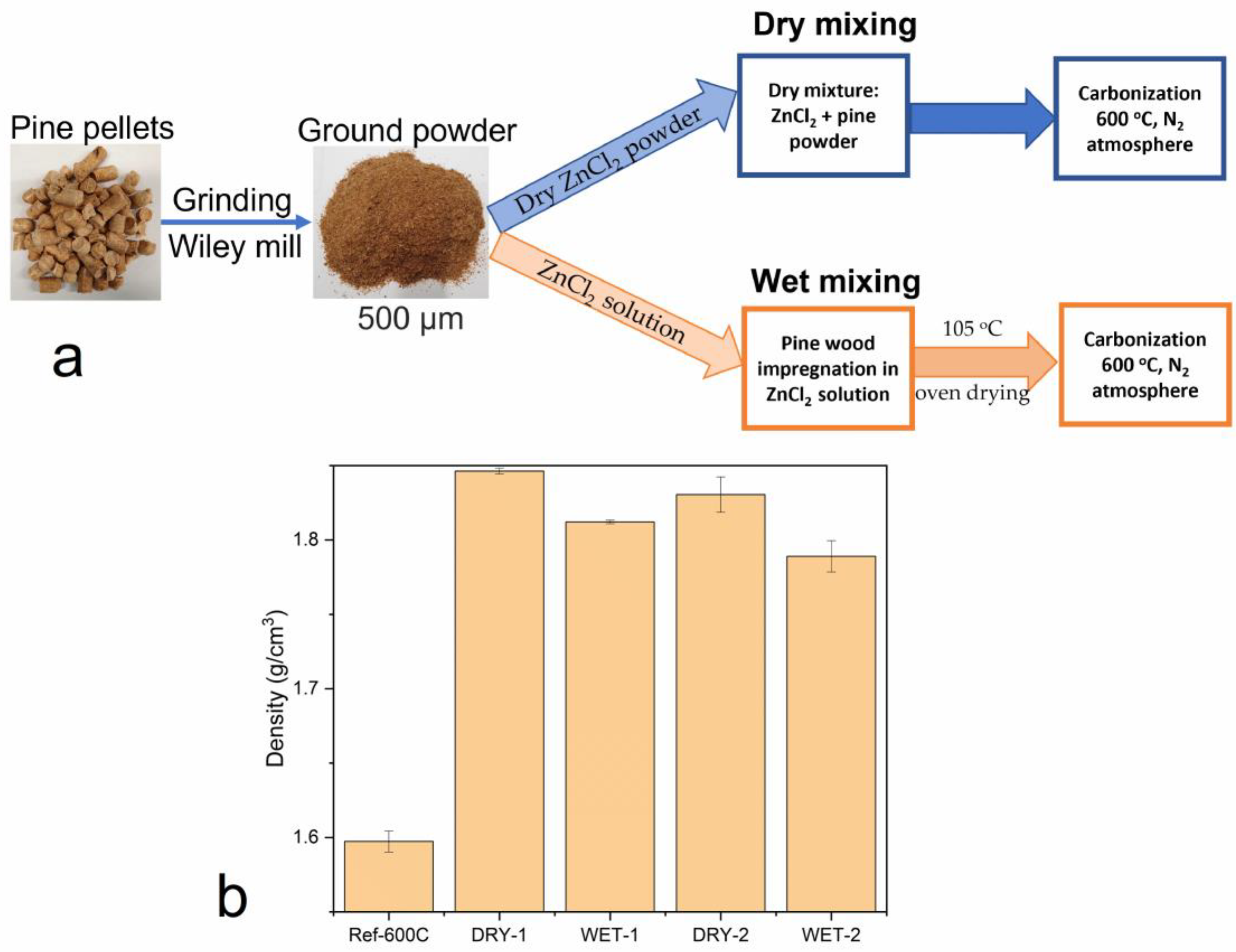


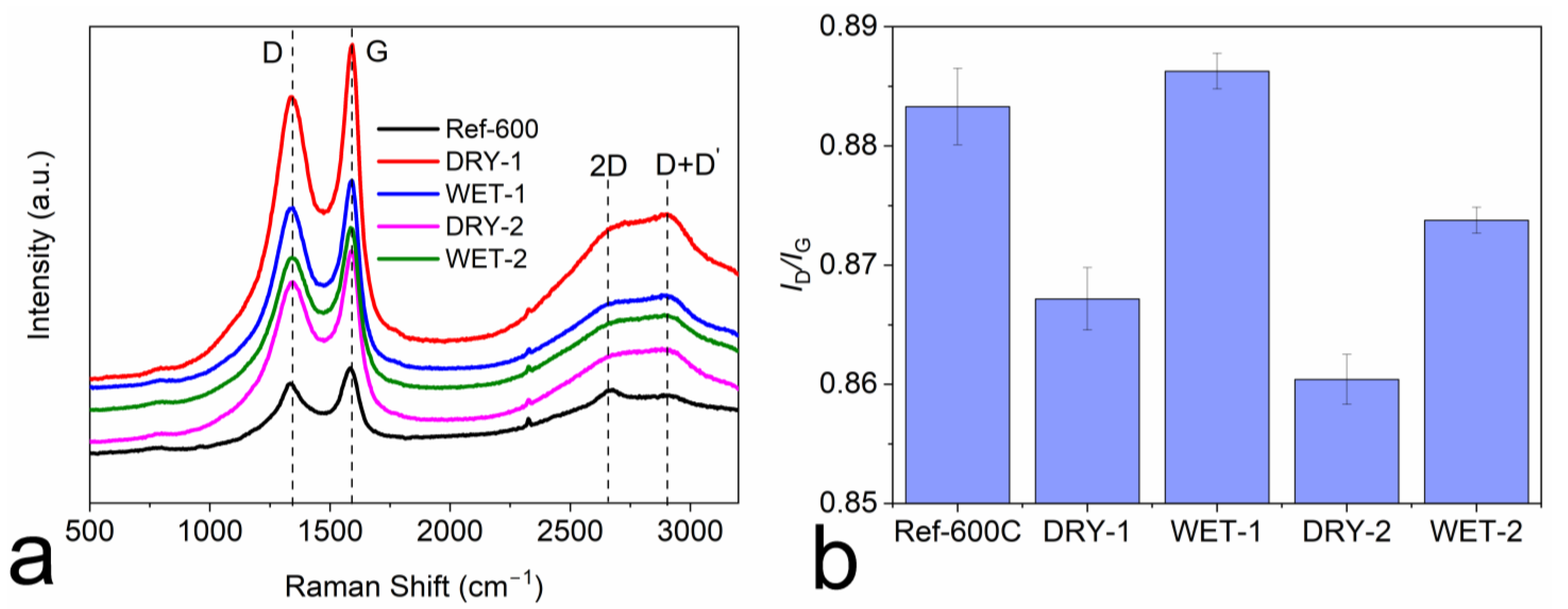
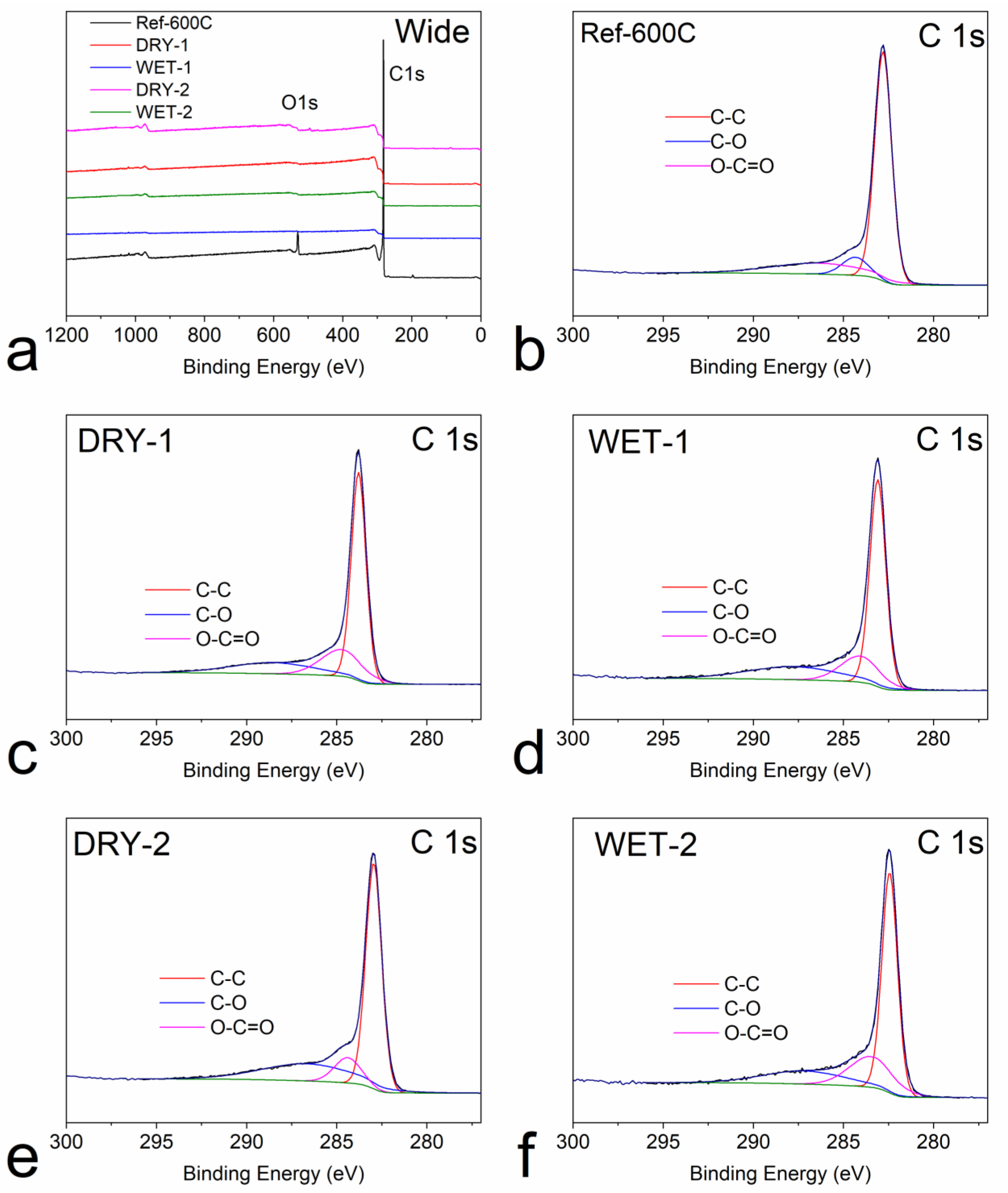

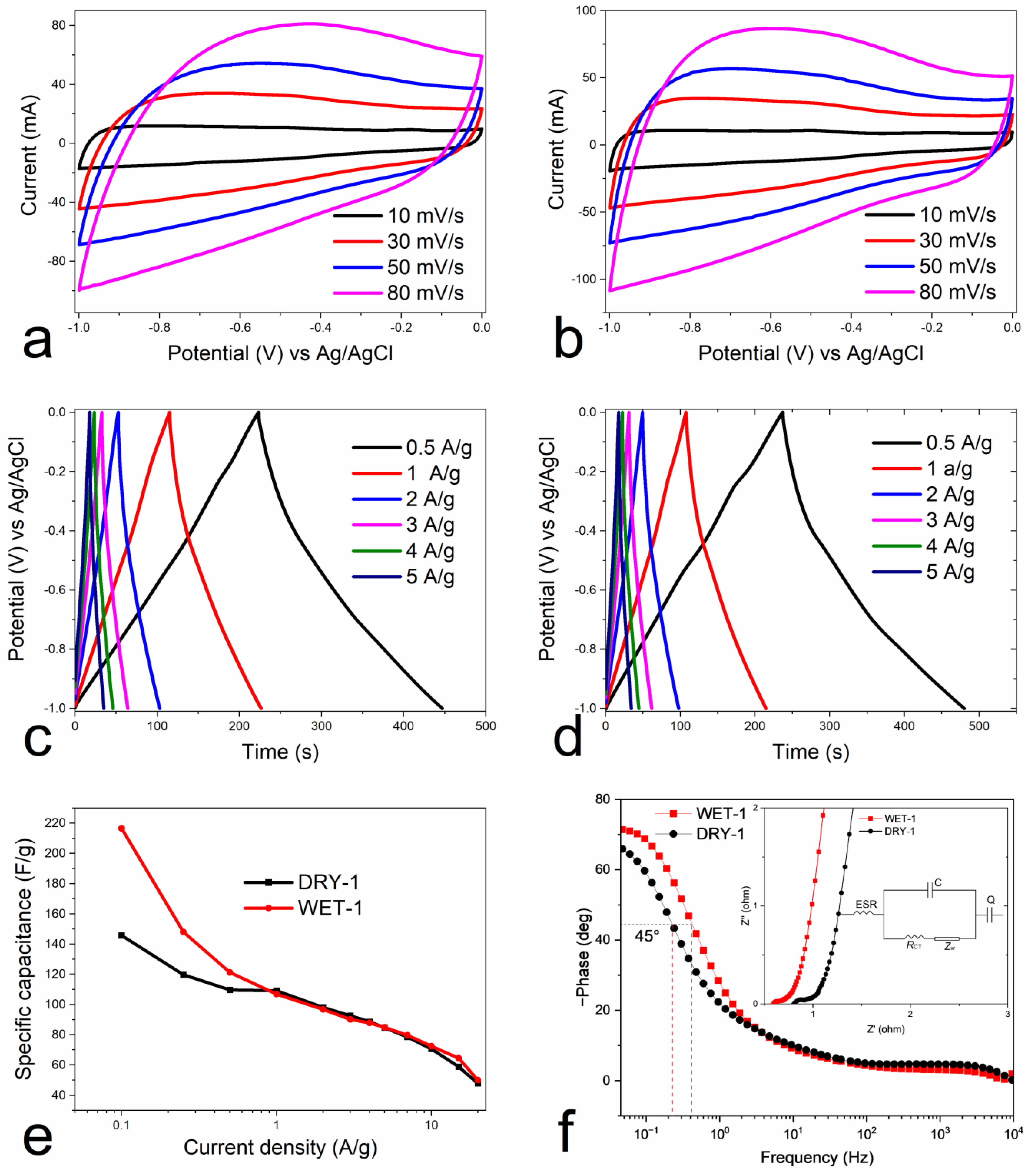
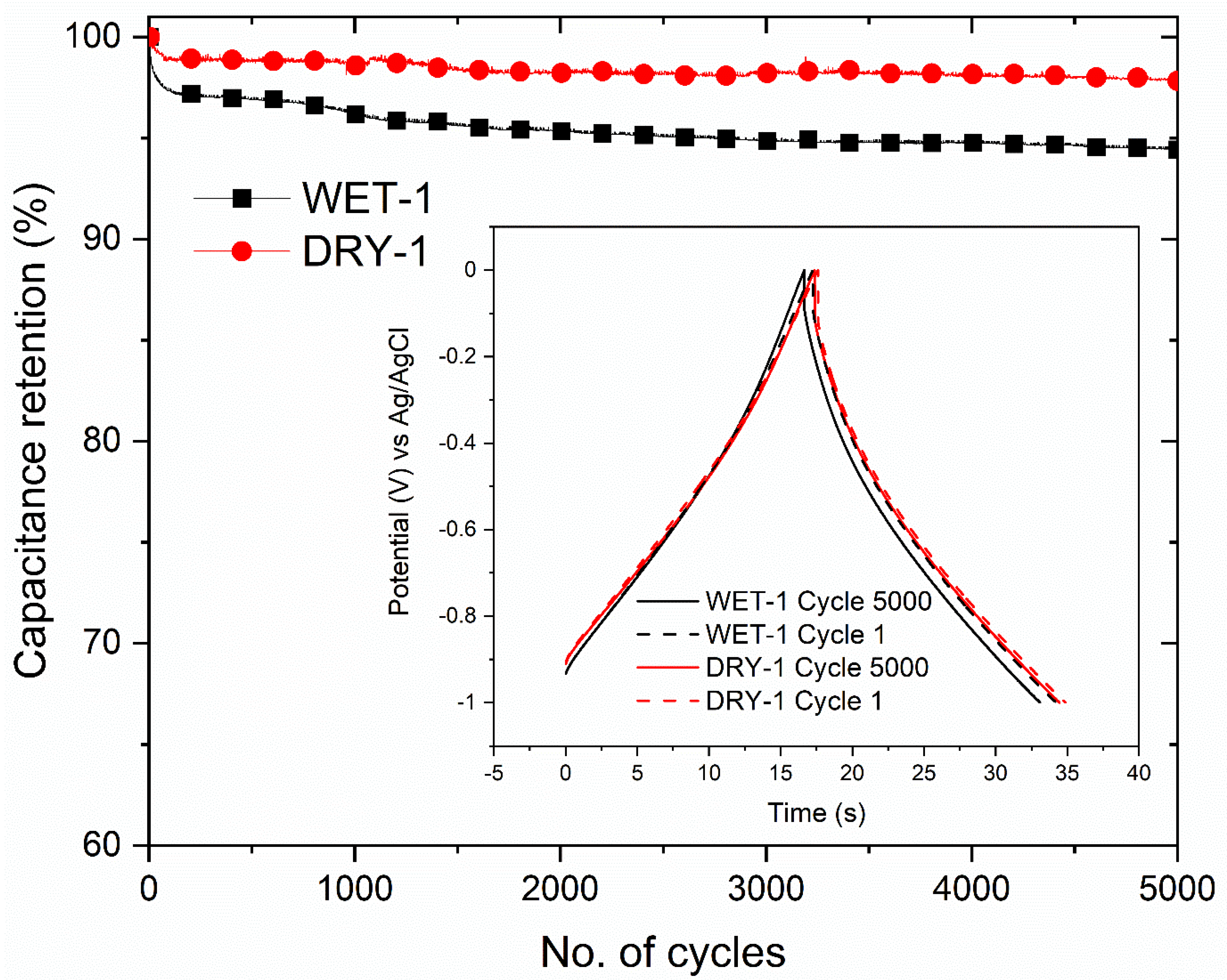
| Samples | C | O | C=C | C-O | O-C=O |
|---|---|---|---|---|---|
| Ref-600C | 93.6 | 5.8 | 71.8 | 8.9 | 19.3 |
| DRY-1 | 96.3 | 3.3 | 59.7 | 21.6 | 18.8 |
| WET-1 | 97.0 | 2.7 | 59.9 | 18.6 | 21.9 |
| DRY-2 | 90.5 | 8.6 | 61.4 | 11.5 | 27.1 |
| WET-2 | 93.7 | 5.9 | 58.3 | 22.9 | 18.8 |
| Samples | Ref-600C | DRY-1 | WET-1 | DRY-2 | WET-2 |
|---|---|---|---|---|---|
| BET surface, (m2/g) | 35 | 1191 | 1263 | 1214 | 1516 |
| t-plot SAmicro, (m2/g) | 17 | 551 | 461 | 437 | 433 |
| t-plot SAExt, (m2/g) | 17 | 639 | 800 | 777 | 1083 |
| t-plot Vmicro, (m3/g) | 0.005 | 0.197 | 0.150 | 0.109 | 0.045 |
| Vtotal, (m3/g) * | 0.019 | 0.637 | 0.664 | 0.753 | 0.954 |
| BJH adsorption, cm3/g | 0.013 | 0.342 | 0.368 | 0.599 | 0.905 |
| BJH desorption, (cm3/g) | - | 0.256 | 0.238 | 0.513 | 0.784 |
| D-H adsorption, (cm3/g) | 0.013 | 0.543 | 0.582 | 0.699 | 0.947 |
| D-H desorption, (cm3/g) | - | 0.237 | 0.219 | 0.482 | 0.751 |
| Horvath-Kawazoe at 0.31, (cm3/g) | 0.017 | 0.578 | 0.626 | 0.610 | 0.767 |
| BJH adsorption pore width, (nm) ** | 2.28 | 2.603 | 2.399 | 2.949 | 2.836 |
| Biomass | Activation Agent | Surface Area m2/g | Electrolye | Specific Capacitance | Capacitance Retention | Reference |
|---|---|---|---|---|---|---|
| Banana fibers | KOH | 957 | 1 M KOH | 324 F/g at 10 mV/s | 100% at 25 A/g 5000 cycles | [59] |
| Coconut shell | ZnCl2 | 1874 | 6 M KOH | 268 F/g at 1 A/g | 99.5% at 3 A/g 5000 cycles | [60] |
| Nori | ZnCl2 | 832 | 6 M KOH | 220 F/g at 0.1 A/g | 96.6% at 2 A/g 5000 cylces | [61] |
| Ramie | ZnCl2 | 1616 | 6 M KOH | 287 F/g at 0.05 A/g | 93% at 0.1 A/g 1000 cycles | [62] |
| Willow wood | KOH | 2793 | 6 M KOH | 394 F/g at 1 A/g | 94% at 5 A/g 5000 cycles | [63] |
| Rice husk ash | HF | 786 | 6 M KOH | 260 F/g at 1 A/g | 84% at 20 A/g 10,000 cycles | [64] |
| Banana Fibers | ZnCl2 | 1097 | 1 M Na2SO4 | 74 F/g at 0.5 A/g | 88% at 0.5 A/g 500 cycles | [65] |
| Bamboo char | KOH | 3061 | 6 M KOH | 258 F/g at 0.1 A/g | 92% at 2 A/g 3000 cycles | [66] |
| Pine wood | - | 76 | 2 M KOH | 328 F/g at 0.2 A/g | 99.7% at 4 A/g 2000 cycles | [67] |
| Wheat straw | KOH | 2115 | 3 M KOH | 294 F/g at 1 A/g | 97.6% at 10 A/g 5000 cycles | [68] |
| Pine wood | ZnCl2 (DRY-1) | 1191 | 6 M KOH | 146 F/g at 0.1 A/g | 97.8% at 5 A/g 5000 cycles | This work |
| Pine wood | ZnCl2(WET-1) | 1263 | 6 M KOH | 247 F/g at 0.1 A/g | 94.4% at 5 A/g 5000 cycles | This work |
Disclaimer/Publisher’s Note: The statements, opinions and data contained in all publications are solely those of the individual author(s) and contributor(s) and not of MDPI and/or the editor(s). MDPI and/or the editor(s) disclaim responsibility for any injury to people or property resulting from any ideas, methods, instructions or products referred to in the content. |
© 2023 by the authors. Licensee MDPI, Basel, Switzerland. This article is an open access article distributed under the terms and conditions of the Creative Commons Attribution (CC BY) license (https://creativecommons.org/licenses/by/4.0/).
Share and Cite
Phiri, J.; Ahadian, H.; Sandberg, M.; Granström, K.; Maloney, T. The Influence of Physical Mixing and Impregnation on the Physicochemical Properties of Pine Wood Activated Carbon Produced by One-Step ZnCl2 Activation. Micromachines 2023, 14, 572. https://doi.org/10.3390/mi14030572
Phiri J, Ahadian H, Sandberg M, Granström K, Maloney T. The Influence of Physical Mixing and Impregnation on the Physicochemical Properties of Pine Wood Activated Carbon Produced by One-Step ZnCl2 Activation. Micromachines. 2023; 14(3):572. https://doi.org/10.3390/mi14030572
Chicago/Turabian StylePhiri, Josphat, Hamidreza Ahadian, Maria Sandberg, Karin Granström, and Thad Maloney. 2023. "The Influence of Physical Mixing and Impregnation on the Physicochemical Properties of Pine Wood Activated Carbon Produced by One-Step ZnCl2 Activation" Micromachines 14, no. 3: 572. https://doi.org/10.3390/mi14030572
APA StylePhiri, J., Ahadian, H., Sandberg, M., Granström, K., & Maloney, T. (2023). The Influence of Physical Mixing and Impregnation on the Physicochemical Properties of Pine Wood Activated Carbon Produced by One-Step ZnCl2 Activation. Micromachines, 14(3), 572. https://doi.org/10.3390/mi14030572







